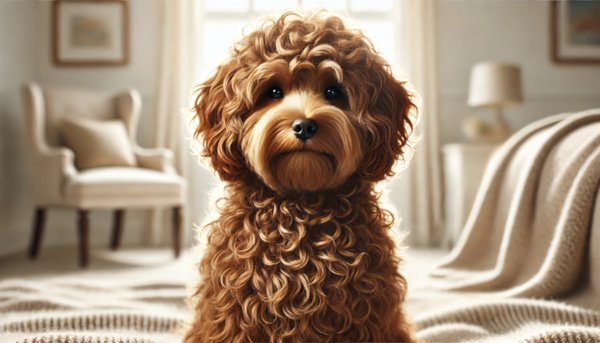
There’s something undeniably cute about a brown Maltipoo. Their deep, chocolate-colored coats paired with those warm, expressive eyes make them stand out in a way that feels almost effortless. These little companions seem to understand their own uniqueness—and they wear it proudly. While every Maltipoo color brings a mix of charm, intelligence, and affection, the brown Maltipoo has an air of rarity.
Brown Maltipoos aren’t as common as their apricot or cream-colored cousins, which only adds to their appeal. The rich hues of their coats, which can vary from a light, warm caramel to a deep, velvety chocolate, come from a specific genetic combination that’s not as easily found.
Table of Contents
- Origins and History of the Brown Maltipoo
- Appearance and Coat Variations of Brown Maltipoos
- Personality and Temperament of Brown Maltipoos
- Health and Lifespan of Brown Maltipoos
- Care and Grooming Needs for Brown Maltipoos
- Training and Exercise for Brown Maltipoos
- Brown Maltipoo Puppy Prices
- Conclusion: Is a Brown Maltipoo Right for You?
Origins and History of the Brown Maltipoo
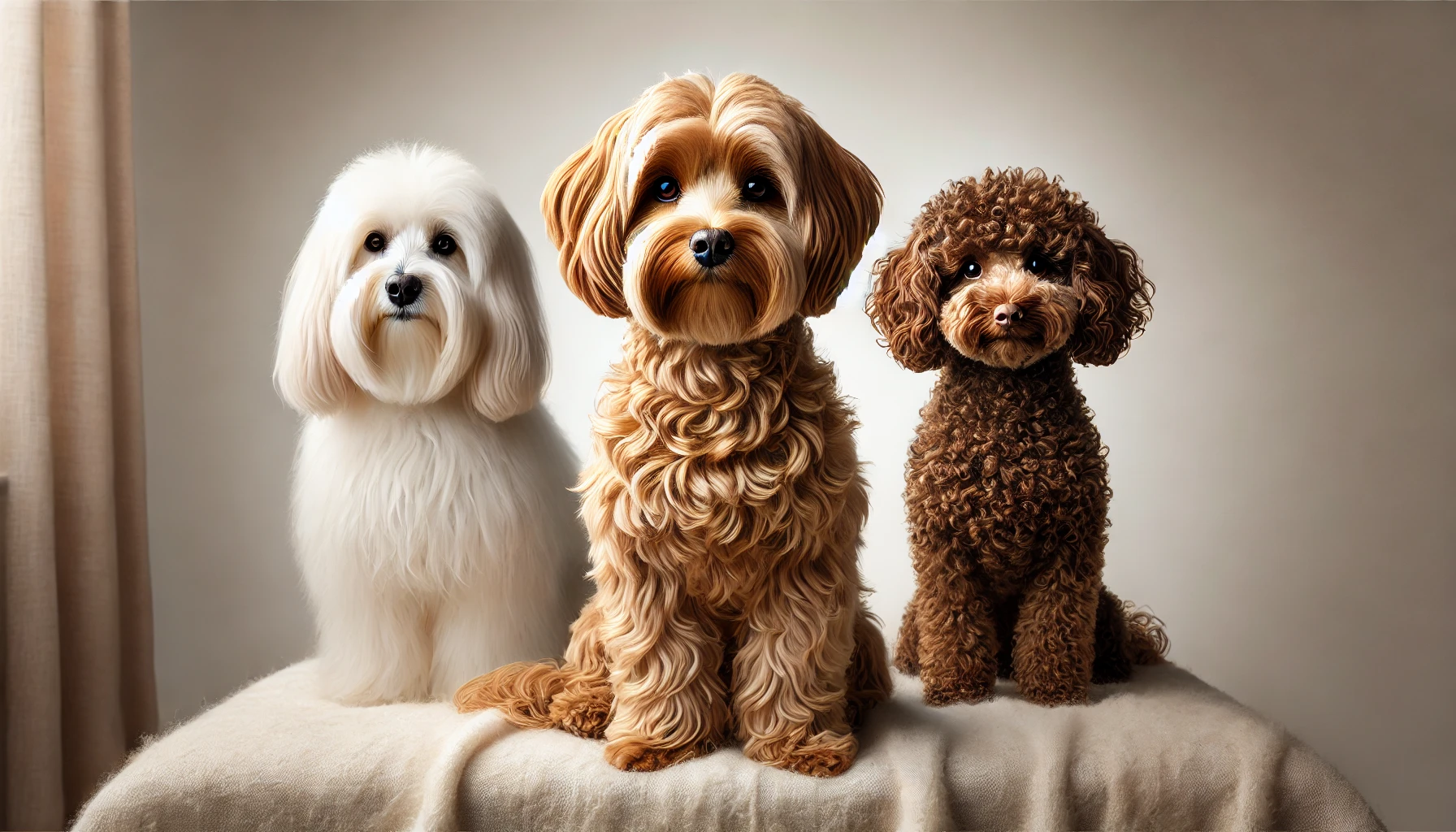
To understand the charm of the brown Maltipoo dog, it’s important to start with its roots. This designer breed is a cross between two established and beloved breeds: the Maltese and the Poodle. Each parent breed brings its distinctive traits to the mix, which in turn brings us the adorable brown teddy bear Maltipoo we know today.
The Maltese
The Maltese breed has a long, noble history that stretches back nearly 3,000 years. Known for their striking, pure-white coats, these small dogs were once the favored companions of royals and aristocrats in ancient Greece, Rome, and Egypt. Their primary role throughout history was simple: to provide companionship and cuddles. Over time, they earned a reputation for being loving lapdogs, perfectly content to be the center of attention. Despite their diminutive size, Maltese dogs are known for their lively and affectionate personalities—a trait that has carried through to their Maltipoo offspring.
RELATED: History and Origins of the Maltese dog
The Poodle
On the other side of the family tree, we have the Poodle—a breed that’s famous for its looks, intelligence, and versatility. Originally bred in Germany as water retrievers, Poodles quickly rose to prominence in France, where they became popular among the French nobility. Known for their sharp minds and distinctive curly coats, Poodles are not only excellent companions but also hypoallergenic, shedding very little dander. This hypoallergenic quality, combined with their trainability and affectionate nature, makes them a perfect match for the creation doodle breeds.
RELATED: 7 Things You Didn't Know About Poodles
How Brown Maltipoos Are Bred
The distinctive brown Maltipoo isn’t just a matter of crossing a Maltese with any Poodle; it requires careful breeding to achieve that rich, chocolatey hue. While Maltese dogs are always white, the color possibilities in Poodles are much more varied. Brown Poodles, in particular, carry a recessive gene—often referred to as the “bb gene”—which results in a true brown coat when combined with the right genetic pairing. This is why the brown Maltipoo is rarer than other color variations like apricot or cream. Breeders must ensure that the Poodle parent carries the recessive gene for brown in order to produce a brown Maltipoo puppy.
Because of this genetic rarity, brown Maltipoos are not as common as their lighter-colored counterparts. The genetic combination required to produce a brown coat is less predictable, which makes each litter a bit of a gamble in terms of color. This also contributes to the increasing demand for brown Maltipoos, as their rarity and unique appearance draw the attention of prospective pet owners looking for something special.
RELATED: 20 Pros and Cons of Owning a maltipoo
Appearance and Coat Variations of Brown Maltipoos
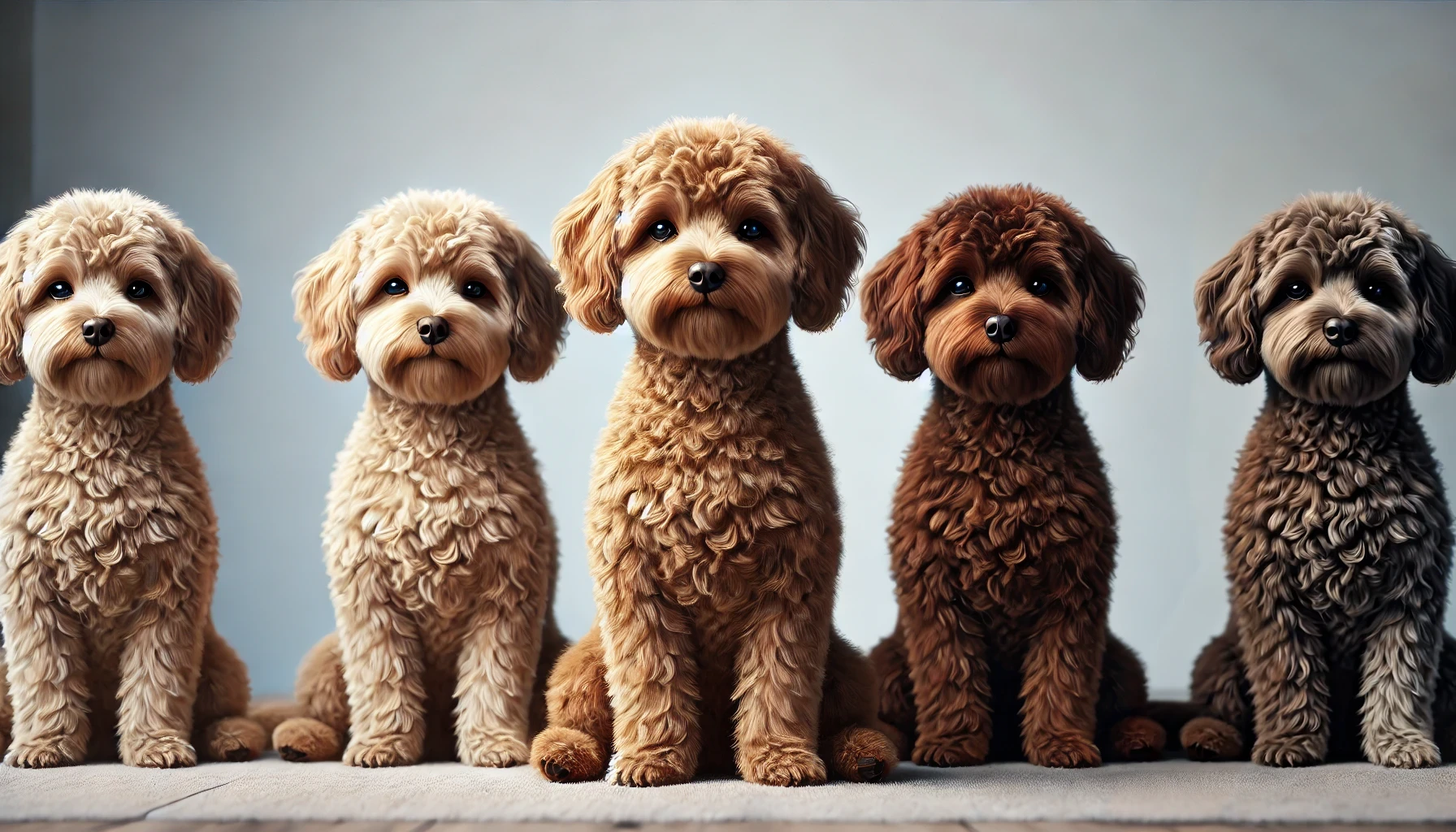
The brown Maltipoo's coat is one of its most striking features. These dogs come in a range of beautiful shades, from deep, rich chocolate to lighter tones like caramel and tan. Some even display cream undertones or a blend of colors that create a truly unique appearance for each pup. The appeal of a brown Maltipoo is often tied to these gorgeous, earthy hues, which give them a distinguished look compared to their more common white or apricot counterparts.
RELATED: The Forever Young and Sweet Maltipoo
Shades of Brown: Chocolate, Caramel, and Tan
One of the most coveted shades is the chocolate Maltipoo, that has a deep, velvety coat. This dark brown hue tends to be the most consistent and intense color in the Maltipoo family. Next, you have lighter tones like caramel and tan, which offer a softer, more golden look.
Some brown Maltipoos have coats that are a mix of these shades, with lighter fur around their face or paws that create a striking contrast. While chocolate Maltipoos tend to keep their color relatively well, some lighter brown Maltipoos may experience subtle changes in their coat over time.
RELATED: Complete Guide To All Maltipoo Colors
The Fading Gene and Coat Changes
One interesting aspect of Maltipoos—particularly those with lighter brown coats—is the presence of what’s known as the fading gene. This gene can cause their coat to gradually lighten as they age. A brown Maltipoo puppy may start out with a deep, chocolate-colored coat, only for it to fade into a lighter shade like cream or tan as they grow older.
RELATED: Everything You Need To Know About Puppy Color Changes
Comparing Brown Maltipoos to Other Coat Colors
While the brown Maltipoo certainly has a unique charm, it’s worth noting how they compare to other popular coat colors within the breed. The apricot Maltipoo, for example, is a fan favorite, often described as resembling a real-life teddy bear with its soft, peachy fur. White Maltipoos are also quite popular, showcasing a classic, pristine look that many dog lovers find appealing. However, these lighter-colored Maltipoos are more prone to tear staining—those reddish-brown marks around the eyes that can sometimes require extra grooming care. Though brown Maltipoos tend to have fewer issues with tear staining, they still require regular brushing to keep their coats healthy and free of tangles.
Personality and Temperament of Brown Maltipoos
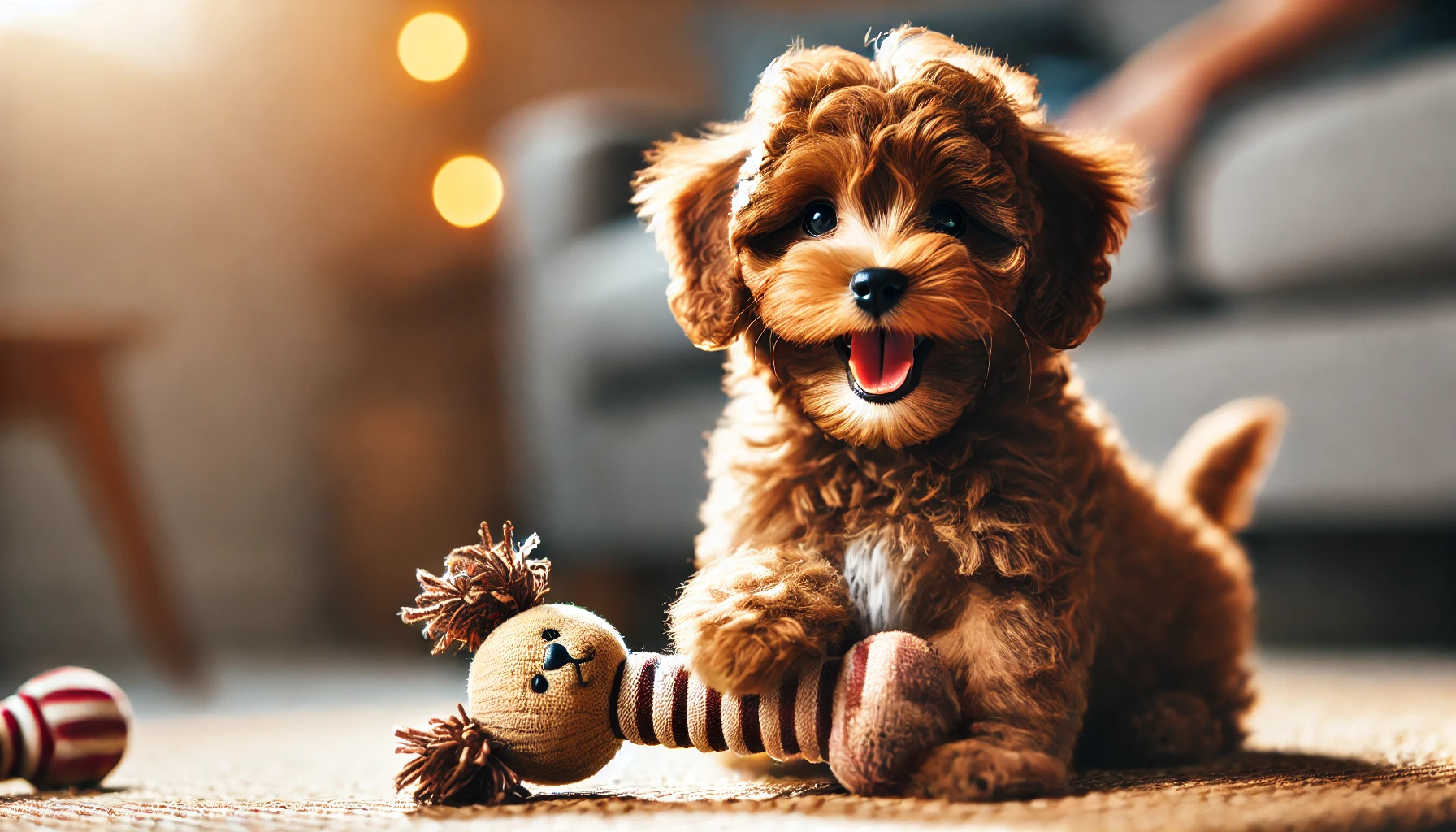
Brown Maltipoos, like their cousins in other colors, are loved for their friendly, affectionate, and gentle nature. These dogs thrive on human interaction and love to be the center of attention. They are perfect companions for families, children, and even seniors, thanks to their easygoing and adaptable personalities.
Compatibility with Families and Children
One of the key reasons Maltipoos, including the brown Maltipoo, are popular with families is their compatibility with children. Their gentle temperament makes them excellent playmates, and their small size means they’re less likely to accidentally knock over a child during play. Maltipoos are also known to be very patient, which makes them a great fit for homes with young kids.
Seniors and Other Pets
For seniors, brown Maltipoos make excellent companions thanks to their manageable size, affectionate disposition, and relatively low exercise needs. They love to cuddle and will happily spend time sitting on laps or following their owners around the house. Additionally, brown Maltipoos are generally good with other pets, especially when properly socialized from a young age. They tend to get along well with both dogs and cats, which adds to their appeal as a versatile, family-friendly breed.
Aggression
One of the most remarkable traits of the Maltipoo temperament is their lack of aggression. These dogs are naturally gentle and friendly, even toward strangers, which makes them excellent pets for households that frequently have visitors. They’re not known for being overly territorial or confrontational, which also contributes to their popularity. Instead, Maltipoos are social creatures who enjoy meeting new people and other animals.
Separation Anxiety in Brown Maltipoos
One thing to be mindful of with brown Maltipoos (and Maltipoos in general) is their tendency to develop separation anxiety. Due to their strong attachment to their families, they can become distressed when left alone for long periods. This breed craves constant companionship, so they may not be the best fit for homes where they’ll be left alone frequently. Signs of separation anxiety can include excessive barking, whining, or destructive behavior when the dog is left by itself. To avoid this, it’s important to train them early on to feel comfortable being alone for short periods and provide plenty of mental stimulation, such as toys or puzzles, when they’re left at home.
RELATED: How To Treat Your Dog's Separation Anxiety
Health and Lifespan of Brown Maltipoos
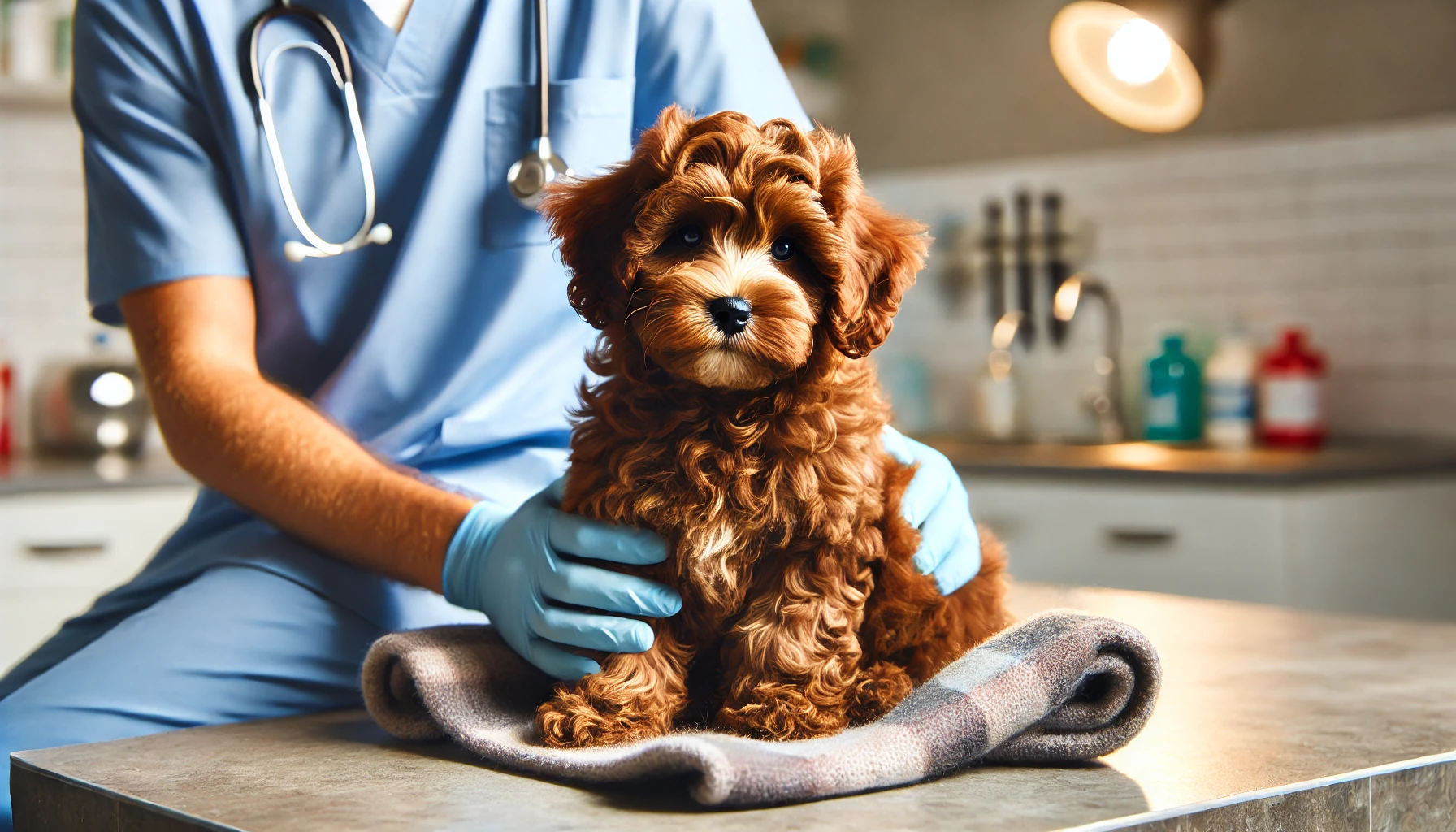
The Maltipoo’s lifespan is one of the breed's most appealing traits, with these dogs often living between 12 and 15 years. However, like any breed, health issues in Maltipoos can arise, particularly those common to small dogs. While brown Maltipoos are generally healthy due to their hybrid vigor—especially in first-generation dogs—it’s important to be aware of some potential health concerns.
Common Health Issues in Maltipoos
Maltipoos, like other small breeds, can be prone to several minor yet manageable health problems. Maltipoo dental care is one area that requires special attention. Small dogs are often more susceptible to dental issues such as tartar buildup and gum disease. Regular brushing and dental checkups are key to preventing these problems from escalating into more serious conditions.
Ear infections are another common issue, particularly in Maltipoos with floppy ears. The shape of their ears can trap moisture, creating the perfect environment for infections to develop. Regular ear cleaning, along with keeping their ears dry after baths or swimming, can help minimize the risk.
Although small breed health problems can include conditions like patellar luxation (a kneecap issue) and hip dysplasia, Maltipoos are not as prone to these as some other small dogs. Still, it’s essential to keep an eye on their mobility as they age and provide them with a healthy diet and regular exercise.
Hybrid Vigor in First-Generation Maltipoos
One of the benefits of owning a first-generation brown Maltipoo (a cross between a purebred Maltese and a Poodle) is hybrid vigor, which refers to the improved health and longevity often seen in first-generation hybrids. This can reduce the likelihood of genetic health issues present in purebred dogs. While this does not make them immune to health problems, it can contribute to a longer and healthier life.
RELATED: What Are F1, F1b, F2 Mixed Breed Generations?
Care and Grooming Needs for Brown Maltipoos
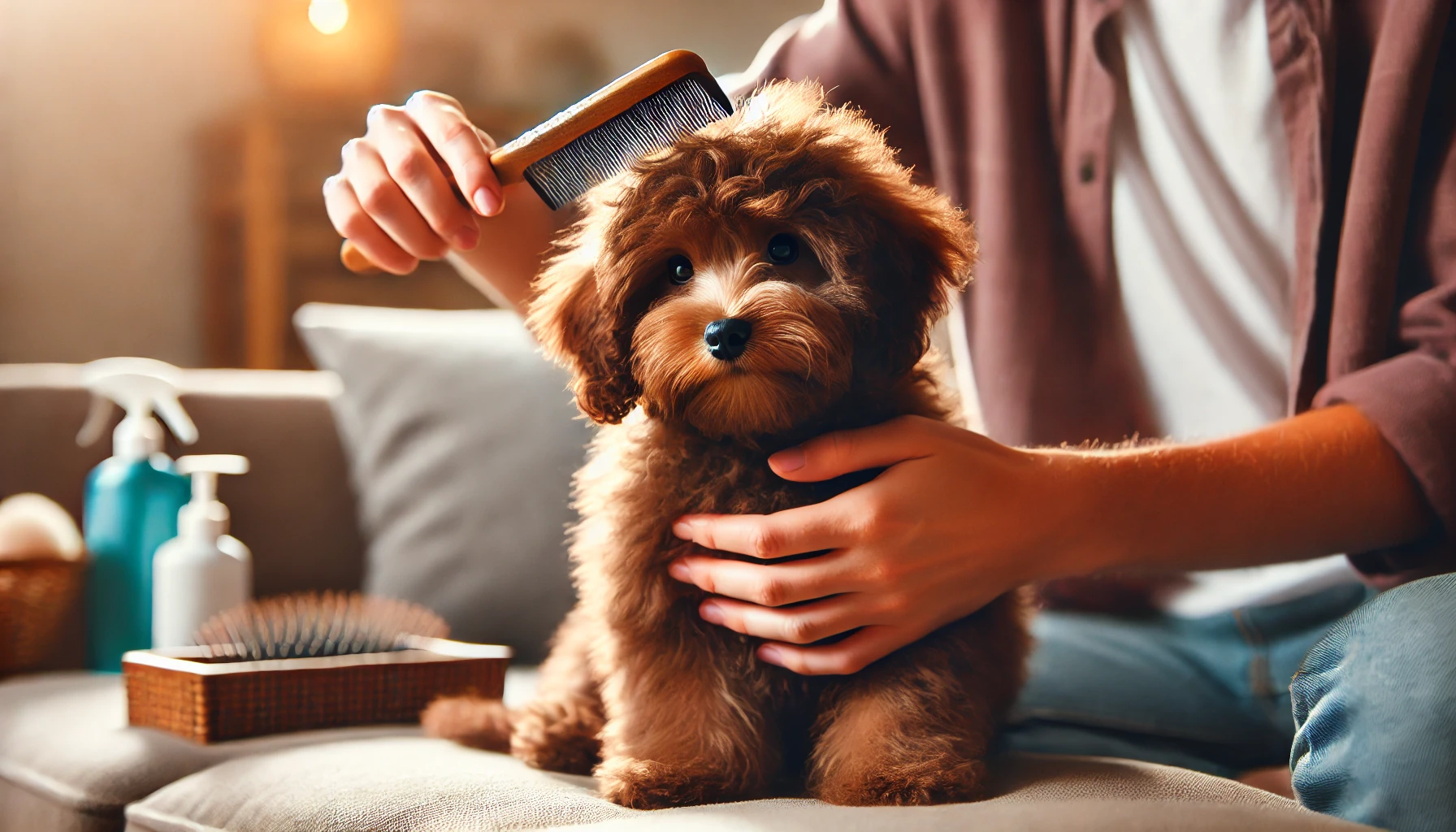
Caring for a brown Maltipoo’s coat requires regular attention to keep them looking their best and feeling comfortable. Maltipoos are known for their soft, wavy to curly coats, which are part of what makes them a popular choice among low-shedding dog breeds. However, with this hypoallergenic, low-shedding coat comes the need for consistent grooming to prevent tangles and maintain their signature teddy bear look.
Brushing and Coat Maintenance
One of the most important aspects of Maltipoo care is regular brushing. Experts recommend brushing your Maltipoo coat (whether it’s chocolate, caramel, or tan) at least 3-4 times a week to prevent matting and tangles. Their coats, while soft, can easily develop knots, especially in high-friction areas like behind the ears or around the legs. Using the best grooming tools for Maltipoos, such as a slicker brush and a metal comb, helps keep their fur smooth and free of debris.
Bathing and Professional Trims
While frequent brushing is essential, bathing your Maltipoo should be done less often, about every 3-4 weeks, unless they get particularly dirty. Overbathing can dry out their skin, which can lead to irritation. Make sure to use a dog-specific, mild shampoo that’s suited for your Maltipoo’s needs, particularly for their sensitive skin.
In addition to home care, it’s a good idea to schedule professional trims every 4-6 weeks. Regular haircuts help maintain the shape and health of their coat, especially around the eyes, paws, and ears, where the fur tends to grow faster and mat easily.
Tear Staining in Maltipoos
Tear staining is a common issue in lighter-colored Maltipoos, particularly those with cream or apricot coats. While brown Maltipoos may not show tear stains as visibly, it’s still important to monitor their eyes. Tear staining occurs due to a buildup of porphyrin, a compound found in tears, which can leave reddish-brown marks around the eyes. Keeping the area clean and dry with a damp cloth can help minimize the staining.
Managing Maltipoo Shedding
Although Maltipoos are considered low-shedding, they are not entirely shed-free. Regular brushing helps manage any Maltipoo shedding.
RELATED: Maltipoo Grooming Guide
Training and Exercise for Brown Maltipoos
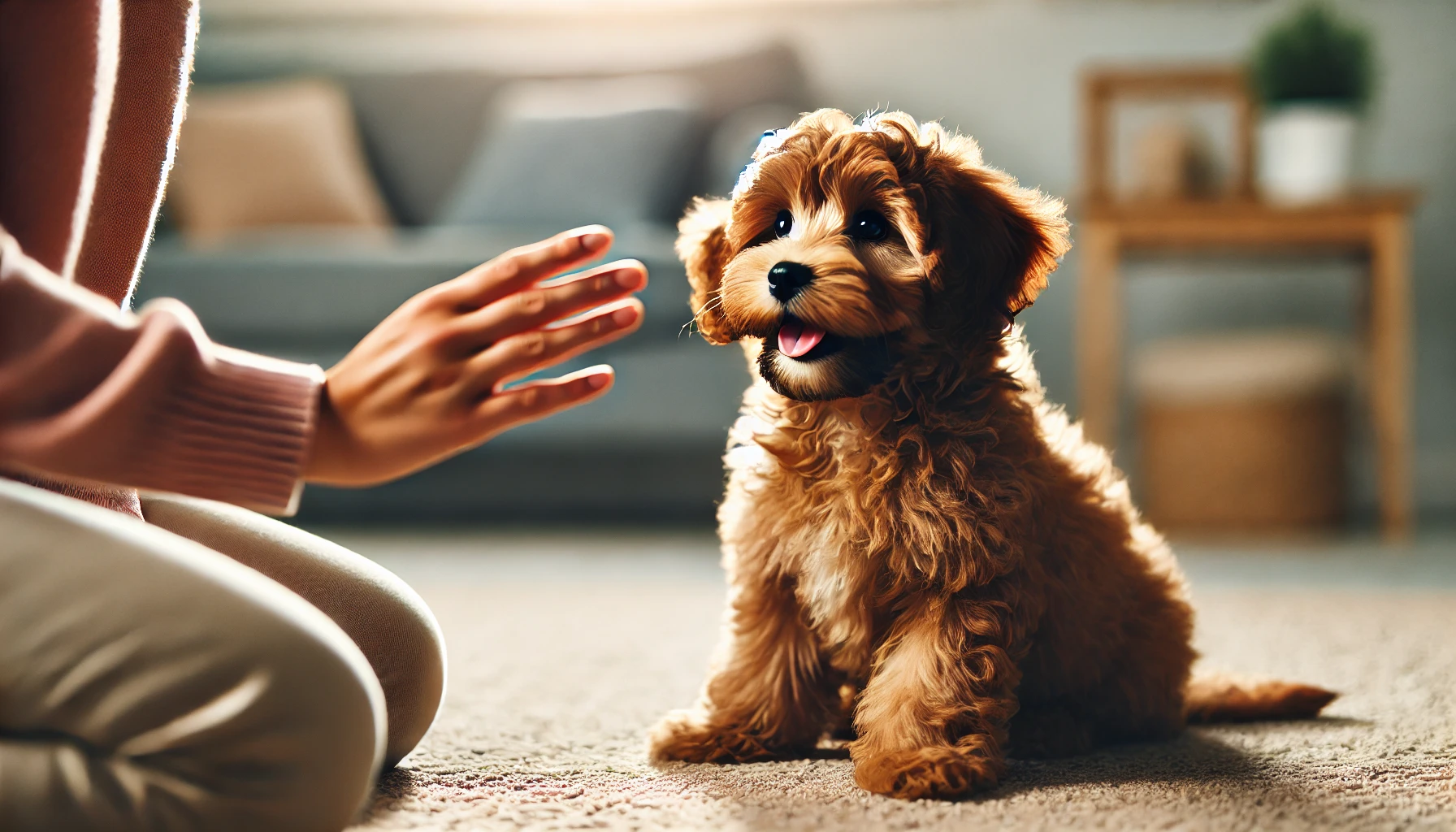
Training a brown Maltipoo is both rewarding and enjoyable, thanks to their high intelligence and eagerness to please. Being Poodle crossbreed dogs, they inherit their sharp minds from their Poodle parent, which means they’re quick learners who excel at picking up commands. However, proper training and socialization are crucial from an early age to ensure they grow into well-rounded, confident adults.
The Importance of Early Socialization and Training
From the time they are puppies, brown Maltipoo puppy training should include early socialization. Exposing your puppy to different environments, people, and other pets will help prevent behavioral issues such as fear or anxiety later on. Maltipoos are naturally friendly, but without proper socialization, they may become timid or overly attached to their owners.
Maltipoos are also known for their sensitive nature, meaning positive reinforcement works wonders during training sessions. Harsh methods will only discourage them, so using treats, praise, and affection is key to building a strong bond and encouraging good behavior.
RELATED: Puppy Socialization Guide
Intelligence and Training Tips
One of the reasons Maltipoo training tips often emphasize patience and consistency is because of the breed’s intelligence. With their Poodle genes, Maltipoos are highly intelligent and capable of learning a variety of tricks and commands. Simple obedience commands like sit, stay, and come can be taught early, but they also excel in more advanced training like agility courses or puzzle toys that stimulate their minds.
Because Maltipoos are quick learners, it’s important to keep training sessions fun and engaging. Repetitive tasks can bore them, so mix things up with a variety of commands or activities. Including mentally stimulating games, like hide-and-seek or obedience challenges, can prevent boredom and reinforce learning.
RELATED: Are Maltipoos smart?
Maltipoo Exercise Needs
While Maltipoos are small, they still have a good amount of energy to spend and benefit from regular exercise. Their exercise routine should include daily walks, playtime, and mentally stimulating activities. Being a small dog for an apartment, they don’t require large spaces to get their energy out, but they do need regular movement to stay happy and healthy. Indoor play is great for days when you can't get outside, and interactive toys that challenge them mentally are an excellent way to burn off extra energy.
Brown Maltipoo Puppy Prices
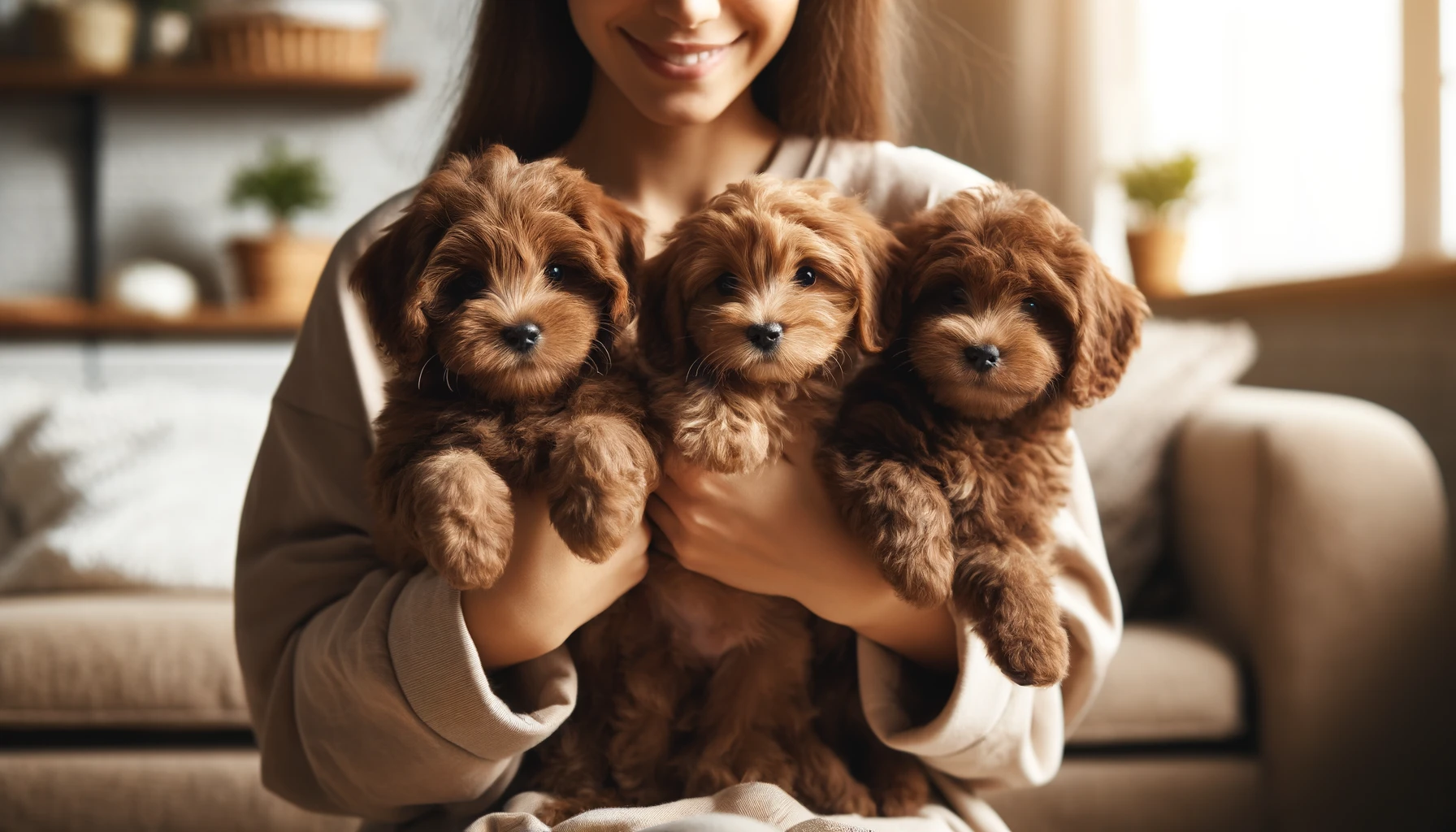
The price range for a brown Maltipoo puppy can be quite wide, often influenced by factors such as coat color, the Maltipoo’s size, breeder reputation, and location. Brown Maltipoos, in particular, are considered rarer than more common color variations like apricot or white. This rarity often leads to higher prices, as the demand for a rare brown Maltipoo continues to grow among prospective owners.
Factors That Affect the Price of Brown Maltipoos
Maltipoos are tiny hypoallergenic dogs known for their low-shedding coats, which makes them popular with allergy sufferers. When it comes to brown Maltipoo puppies, the color rarity can drive prices even higher. Brown coats are less common due to the specific genetic pairing needed to achieve the rich chocolate or caramel hues. As a result, the Maltipoo price range for these rare-colored pups can vary from $1,500 to $4,000 or more, depending on the breeder and the puppy’s lineage.
Choosing a Reputable Breeder
When finding reputable breeders, especially those who specialize in rare colors like brown, it’s crucial to do your research. A reputable breeder will not only provide a healthy puppy but will also ensure that both parents have been screened for common health issues.
A responsible breeder will also provide you with health clearances for the puppy’s parents, showing that they are free of known genetic conditions. This kind of screening is important for the long-term well-being of your puppy.
How to Find Rare Maltipoos
If you’re specifically looking for a rare brown Maltipoo, it may take time and patience to find the right puppy. Keep in mind that finding reputable breeders who adhere to ethical breeding practices should always take priority over finding the lowest price.
RELATED: See available brown Maltipoo puppies for sale at Premier Pups
Conclusion: Is a Brown Maltipoo Right for You?
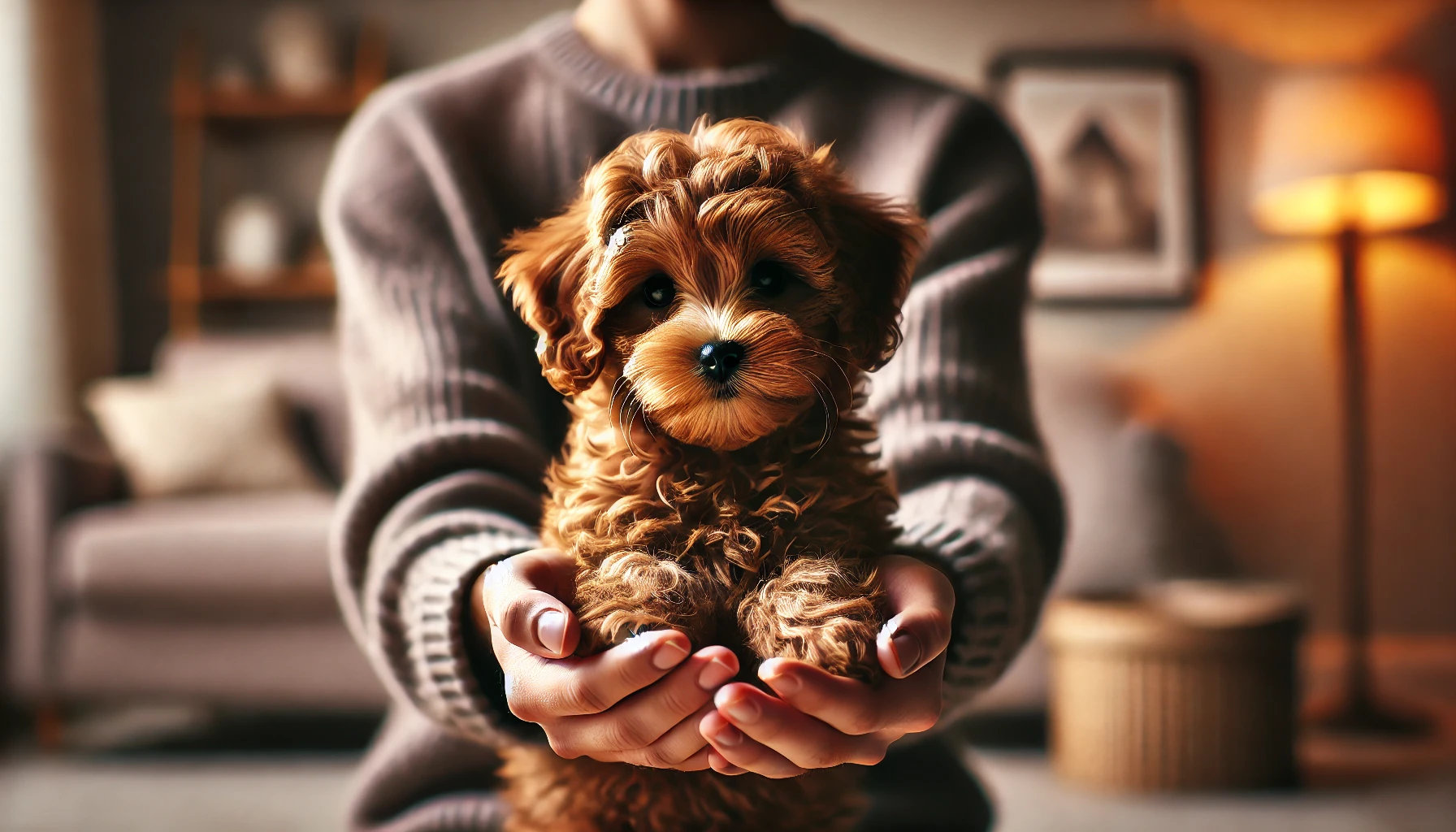
The brown Maltipoo is a delightful combination of beauty, intelligence, and affection, which make it a top choice for many. With their warm temperament, characterized by friendliness and a desire for companionship, these dogs fit seamlessly into various living situations, from family homes to apartments. However, as with any breed, it's important to consider whether a Maltipoo’s needs match your lifestyle.
Key Points to Consider:
- Temperament: Maltipoos are affectionate and thrive on human companionship. If you have a home where your dog can be involved in daily activities and spend plenty of time with you, the Maltipoo will fit in perfectly. However, if you’re often away, this breed may develop separation anxiety, as they do best with constant interaction.
- Exercise Needs: While they don’t need vigorous exercise, Maltipoos do benefit from daily walks and interactive play. Their Maltipoo exercise needs are moderate, making them an excellent fit for both active households and those looking for a smaller dog that enjoys play but doesn’t require intense activity.
- Living Space: Being a miniature Poodle mix, Maltipoos are small and adaptable, making them an ideal small dog for apartment living. Their size, combined with their low-shedding coat, means they are a good choice for those with limited space or allergy concerns.
- Care and Grooming: Regular grooming is essential to keep their hypoallergenic coats looking their best. While their coats are low-shedding, they do require regular maintenance, including brushing, ear cleaning, and dental care.
Ultimately, the brown Maltipoo is a perfect choice if you’re looking for a loving, low-shedding companion who thrives on attention and is easy to train. If these traits resonate with your lifestyle, a brown Maltipoo might just be the perfect fit for you!
Scroll Down to See FAQs about brown Maltipoos.
What To Read Next
How Long Do Maltipoos Live?
Do Maltipoos Shed?
Frequently Asked Questions
Are Maltipoos good with kids? Yes, Maltipoos are great with kids! Thanks to their friendly and affectionate temperament, they make excellent family pets. Their small size also makes them less likely to unintentionally knock over a child during play. However, like all dogs, it’s important to supervise interactions between small children and the dog to ensure both are respectful and safe.
Do brown Maltipoos fade? Yes, some brown Maltipoos may fade as they age, particularly if they inherit the "fading gene" from their Poodle parent. This gene can cause their rich chocolate or caramel coats to lighten over time, sometimes turning into a lighter brown, cream, or even a silvery color. This is more common in Maltipoos with lighter brown coats, but it can happen in darker-colored pups as well.
Do brown Maltipoos change color? Yes, brown Maltipoos can change color as they grow older. Like many Poodle mixes, Maltipoos often experience coat color changes due to genetics. Puppies that start with a dark brown coat may lighten to a tan, cream, or cafe au lait shade as they mature. This is a gradual process that typically occurs during the first few years of their life.
Are brown Maltipoo puppies hard to find? Yes, brown Maltipoo puppies are harder to find compared to more common colors like white or apricot. The brown color is the result of a recessive gene, meaning both parents must carry this gene to produce a brown puppy. This genetic rarity, combined with increasing demand, makes brown Maltipoos more difficult to come across, often resulting in higher prices and waitlists from reputable breeders. If you’re specifically looking for a brown Maltipoo, it may take some time and effort to locate one.




